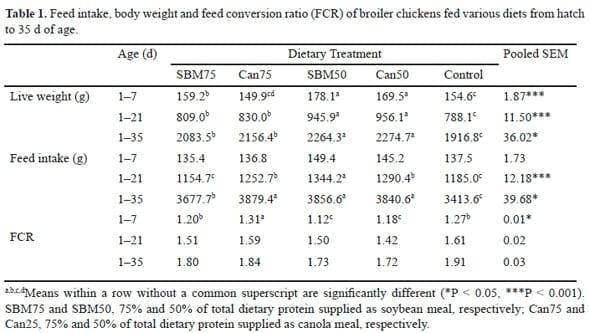Diets for broiler chickens
Performance of broiler chickens fed diets based on all-vegetable ingredients

Berg, C. and Sanotra, G.S. (2003). Can a modified latency-to-lie test be used to validate gait-scoring results in commercial broiler flocks? Animal Welfare 12, 655-659.
National Research Council (1994). Nutrient Requirements of Poultry, 9th edition.National Academy Press, Washington, D.C.
Dear Professor Paul ,
Please clarify me on the below subject matter whether i am correct or wrong? and please share your views regarding the same to update our knowledge.
I feel the study is not complete as you have considered only Fish Meal as a Non Veg Protein source.
I hereby request you to take the trial with Meat cum Bone meal @ 4 -5 % inclusion rate & please assure that the MBM received should be from the manufacturer having hi tech rendering technology plants at their abattoirs.
I am not agree with the Comments of Dr Anant Deshpande regarding the Indian Broiler feed industry as In India maximum broiler feed manufacturers are using the MBM as a main ingredient for Protein & Phosphorus source expect who have religious issue. In India everybody is not able to get the good quality material produced by the manufacturers who are using the Hi tech rendering technology plants provided by Alfa Laval & Flow Dry companies.
In India two types of MBM producers are there, One having integrated slaughter houses who have hi tech rendering machineries and utilizing their own abattoir waste coming from their own in house slaughter lines and others having traditional machineries who collect the waste material from surrounding areas and process the same with the help of traditional machineries to produce MBM & Animal Fat. The produce came out from such traditional manufacturers contains lot of microbial contamination and which is not fit for the poultry.
For the support of this i am herewith providing some field results got from one of Maharashtra based company having Broiler Integration business & is using Sterilized MBM @ 4% on very regular basis in finisher & starter feed procured from the manufacturer having hi tech rendering plants at their abattoirs.
Name of Farmer DOC Date of placement Mean age Chick source/Breed Av.Body weight(Kg) FCR Mortality%
Mr. Shaikh S 4049 02.04.2009 47 Phonix Poultry-Jabalpur/Cobb400 2.213 1.77 6.22
Mr. Gorakh Dhamore 5044 02.04.2009 46 Phonix Poultry-Jabalpur/Cobb400 2.218 1.76 4.18
Mr. Arun Kadus 5138 24.04.2009 48 Shanti Fortune-Bangalore/Cobb400 2.358 1.80 7.73
Mr.Shivaji Kadus 5220 24.04.2009 44 Shanti Fortune-Bangalore/Cobb400 2.077 1.75 5.10
Mr. Jagannath Kadus 5452 24.04.2009 49 Shanti Fortune-Bangalore/Cobb400 2.368 1.81 5.10
Mr. Namdev Kale 8149 24.04.2009 48 VSN Hatch. Nanded/Cobb400 2.184 1.75 3.74
Mr. Dilip Maid 5079 24.04.2009 48 VSN Hatch. Nanded/Cobb400 2.331 1.73 3.54



Dear Dear Professor Paul & Mr. M.A. Hossain,
I feel the study is not complete as you have considered only Fish Meal as a Non Veg Protein source.
I hereby request you to take the trial with Meat cum Bone meal @ 4 -5 % inclusion rate & please assure that the MBM received should be from the manufacturer having hi tech rendering technology plants at their abattoirs.
I am not agree with the Comments of Dr Anant Deshpande regarding the Indian Broiler feed industry as In India maximum broiler feed manufacturers are using the MBM as a main ingredient for Protein & Phosphorus source expect who have religious issue. In India everybody is not able to get the good quality material produced by the manufacturers who are using the Hi tech rendering technology plants provided by Alfa Laval & Flow Dry companies.
In India two types of MBM producers are there, One having integrated slaughter houses who have hi tech rendering machineries and utilizing their own abattoir waste coming from their own in house slaughter lines and others having traditional machineries who collect the waste material from surrounding areas and process the same with the help of traditional machineries to produce MBM & Animal Fat. The produce came out from such traditional manufacturers contains lot of microbial contamination and which is not fit for the poultry.
For the support of this i am herewith providing some field results got from one of Maharashtra based company having Broiler Integration business & is using Sterilized MBM @ 4% on very regular basis in finisher & starter feed procured from the manufacturer having hi tech rendering plants at their abattoirs.
Name of Farmer DOC Date of placement Mean age Chick source/Breed Av.Body weight(Kg) FCR Mortality%
Mr. Shaikh S 4049 02.04.2009 47 Phonix Poultry-Jabalpur/Cobb400 2.213 1.77 6.22
Mr. Gorakh Dhamore 5044 02.04.2009 46 Phonix Poultry-Jabalpur/Cobb400 2.218 1.76 4.18
Mr. Arun Kadus 5138 24.04.2009 48 Shanti Fortune-Bangalore/Cobb400 2.358 1.80 7.73
Mr.Shivaji Kadus 5220 24.04.2009 44 Shanti Fortune-Bangalore/Cobb400 2.077 1.75 5.10
Mr. Jagannath Kadus 5452 24.04.2009 49 Shanti Fortune-Bangalore/Cobb400 2.368 1.81 5.10
Mr. Namdev Kale 8149 24.04.2009 48 VSN Hatch. Nanded/Cobb400 2.184 1.75 3.74
Mr. Dilip Maid 5079 24.04.2009 48 VSN Hatch. Nanded/Cobb400 2.331 1.73 3.54

our salient focus on all-vegetable diets using for the broiler chickens and looking into the effects comparing with animal feed ingredients ,and its improvement for optimum production of the chickens. So the nomenclature of the title of our article should be on botanical related
cheers











.jpg&w=3840&q=75)